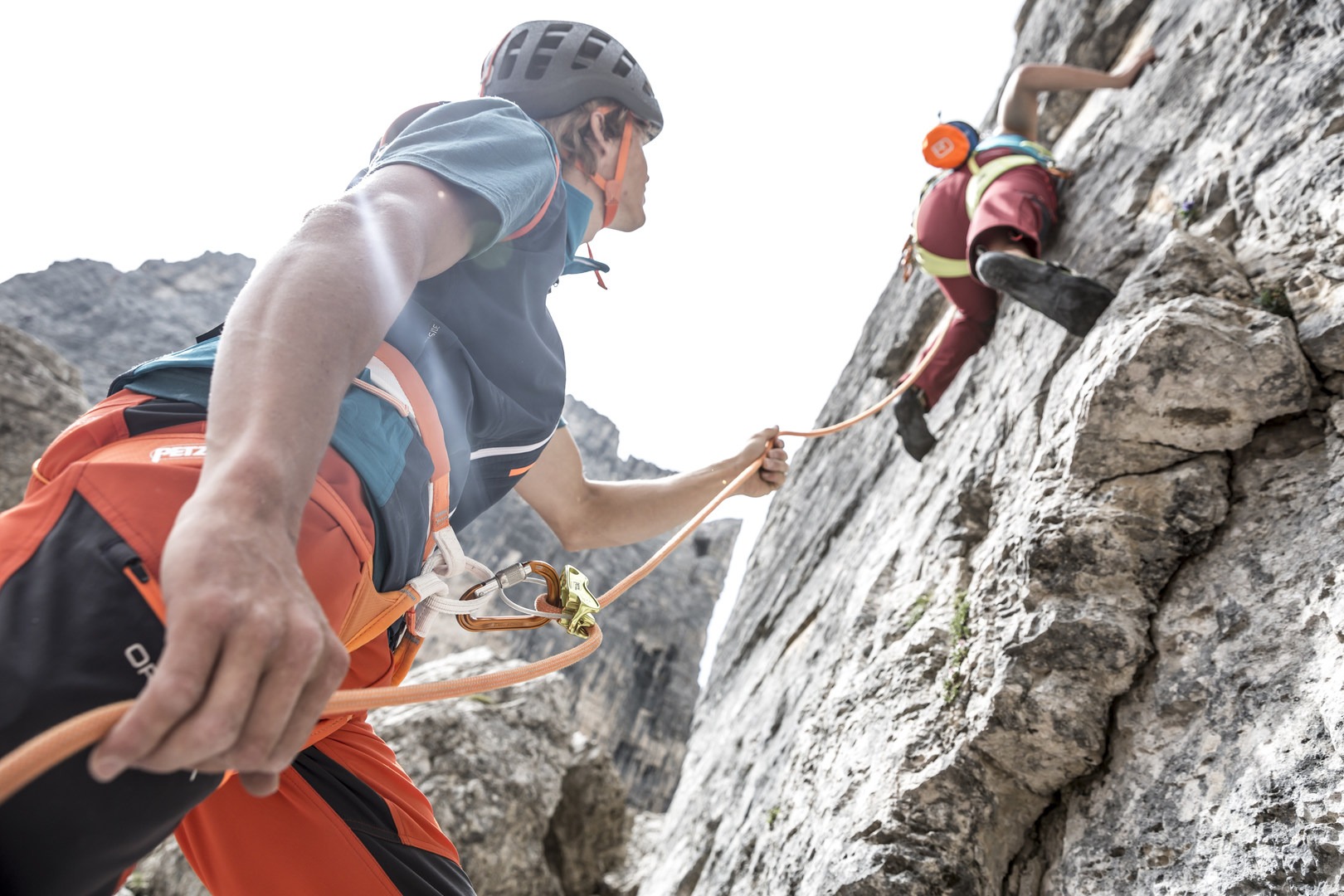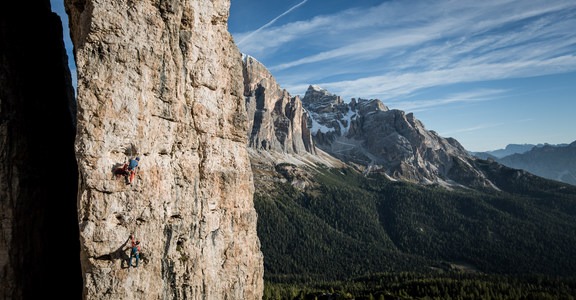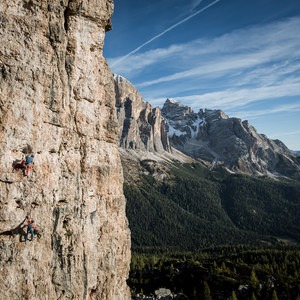Staying safe with the right equipment
You can’t climb without equipment. And if you go alpine climbing, you’ll need even more equipment. Alongside your personal ability and the conditions, having the correct high-quality equipment is a key variable in mountaineering. Mountaineering equipment is therefore subject to various standards with which it must comply. In addition to the European Standard (EN), there is also the UIAA standard (Union Internationale des Associations d’Alpinisme), which has become the global benchmark.
Basic equipment for groups
If a multi-pitch route is secured in a way suitable for climbing for fun (equipped with bolts at short intervals, with belays available) and if no mobile belay equipment is required, the following equipment will be useful for each rope team. Of course, this may vary according to the type of tour.
Rope
Dynamic ropes are used in alpine and sport climbing. Thanks to their elasticity, they can absorb fall energy better than static ropes. This can thus reduce the impact force acting on the climber. Static ropes, on the other hand, are used as fixed ropes for ascending and descending.
There are three different types of dynamic ropes: single, half and twin ropes
- Single rope: A single rope is recommended for sport climbing. The diameter is between 8.9 and 10.5mm. Unlike the half rope or twin rope, single ropes offer no redundancy, which is not absolutely necessary in sport climbing. In alpine climbing, on the other hand, falling rocks or sharp edges could destroy the rope. Likewise, rappelling over the entire rope length is not possible with single rope.
- Half rope: Half ropes are used on alpine rock routes. Redundancy is important in this terrain as a safety reserve in case a rope breaks. Half ropes are also important when retreating and rappelling, as the climber can knot both ropes together at the end of the rope and abseil down the entire length. In addition, with the right climbing technique, you can avoid rope friction. A half rope is 8 to 9mm thick and is usually 60m long for alpine climbing.
- Twin rope: Twin ropes also offer redundancy. They are optimized to be lightweight and are between 7.5 and 8mm thick, which means that they do not have the same sturdiness as half ropes when subjected to heavy impact from edges or falling. However, twin ropes are only intended for two-man rope teams – not to protect two second climbers.
NOTE! The operating life of all items of equipment made from plastic or textiles is maximum 10 years. Belts, ropes, helmets, etc. must be replaced after 10 years at the very latest – even if they have not been used. In the case of heavy wear, it is possible that items must be discarded far earlier – in extreme cases (e.g. a serious fall) after one use.
Climbing backpack
A good climbing backpack for alpine tours is light, slim, sits close to the back and is made of sturdy material. This ensures maximum freedom of movement, an optimal center of gravity and minimum weight. Finally, it needs to be possible to carry it pitch after pitch for hours on the rock face.
Quickdraws
Quickdraws are an essential part of the basic equipment of any rope team. They consist of two carabiners attached with a piece of sling material. They have a protection or bolt side, which is clipped into the rock, and a rope side, into which the rope is clipped. The sling has some room for maneuver on the hook side to prevent tilting and transverse stress. On the rope side, the carabiner is usually fixed with a small rubber to prevent twisting. On alpine routes, it is advisable to take along extendible quickdraws in order to reduce any rope friction and to simplify handling.
Topographic map
A topographic map is a representation of a climbing route. The length, course, belays, overhangs etc. are indicated on it. Uniform, standardized symbols are used when creating topographic maps.
First aid kit / bivi bag
A first-aid kit and bivi bag are minimum requirements for a rope team’s equipment. The following products must be included in a first aid kit: triangular bandage; gauze bandage; roll of adhesive medical tape; disposable gloves; small scissors; wound compress; bandage set. A good first aid kit should be clearly arranged and have an all-round zipper or a sufficiently large opening. In addition, each rope team must carry a double bivi bag in order to stay protected on the cliff face in the event of an emergency.
Check out the full series of Safety Academy Lab Rock videos below:
- Alpine basics
- Basic equipment for every climber
- Basic equipment for groups
- Additional equipment for groups
- Storms in the mountains
- Types of rock in the Alps
- Tour planning for alpine climbing
- Packing a backpack correctly
- Rope team procedures
- Knot techniques
- Belay using bolts
- Belay methods
- Anchors
- Coiling a climbing rope
- Rappelling
- What to do in an alpine emergency
- First aid on the mountain
- Rescue techniques while alpine climbing
- Bivouacking in an emergency situation
Visit ORTOVOX’s Safety Academy Lab Rock to view the climbing tutorials in their totality and test your knowledge with their fun and interactive quizzes.
Since the company was founded in 1980 in the south of Munich, ORTOVOX has stood for the highest possible protection during alpine activities. As pioneers in the avalanche safety field, we have played a key role in the development of emergency equipment for the mountains. Innovations such as the double-frequency avalanche transceiver and Smart Antenna Technology, and also targeted training measures, continue to be valuable contributions to making mountain sports a little bit safer and to saving lives.






Comments
Sign In and share them.